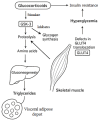Lipid Hormones at the Intersection of Metabolic Imbalances and Endocrine Disorders
- PMID: 40729034
- PMCID: PMC12293429
- DOI: 10.3390/cimb47070565
Lipid Hormones at the Intersection of Metabolic Imbalances and Endocrine Disorders
Abstract
Lipid hormone imbalances involving glucocorticoids, thyroid hormones (THs), and sex hormones have widespread metabolic consequences, contributing to the global increase in obesity and insulin resistance. This review examines the complex role of disrupted lipid hormone pathways in the development of metabolic disorders, particularly metabolic dysfunction-associated steatotic liver disease (MASLD). Endocrine disorders such as hypercortisolism, hypothyroidism, and polycystic ovary syndrome (PCOS) are closely linked to MASLD through shared metabolic pathways. Mechanisms include glucocorticoid-induced gluconeogenesis and lipolysis, impaired lipid clearance in hypothyroidism, and the hyperandrogenism-induced downregulation of hepatic low-density lipoprotein (LDL) receptors. PCOS-related factors-such as central obesity, adipocyte hypertrophy, low adiponectin levels, and genetic predisposition-further promote hepatic steatosis. Thyroid dysfunction may also impair the hepatic deiodination of T4, contributing to lipid accumulation and inflammation. Given the overlapping pathophysiology among endocrine, hepatic, and reproductive disorders, multidisciplinary collaboration is essential to optimize diagnosis, treatment, and long-term cardiometabolic outcomes.
Keywords: MASLD; PCOS; androgens; glucocorticoids; insulin resistance; thyroid hormones.
Conflict of interest statement
The authors declare no conflicts of interest.
Figures






Similar articles
-
POLYCYSTIC OVARY SYNDROME: ORIGINS AND IMPLICATIONS: Polycystic ovary syndrome: the impact of androgen excess on metabolic health.Reproduction. 2025 Jul 4;170(2):e250102. doi: 10.1530/REP-25-0102. Print 2025 Aug 1. Reproduction. 2025. PMID: 40548832 Review.
-
Steatotic liver disease arising in an asymptomatic 20-year-old man with panhypopituitarism and elevated transaminases.Can Liver J. 2024 Dec 19;7(4):511-516. doi: 10.3138/canlivj-2024-0030. eCollection 2024 Dec. Can Liver J. 2024. PMID: 40677524 Free PMC article.
-
Endocrinologist's crucial role in metabolic dysfunction-associated steatotic liver disease: a comprehensive review.Minerva Endocrinol (Torino). 2025 Jun;50(2):209-226. doi: 10.23736/S2724-6507.24.04314-8. Epub 2025 Mar 21. Minerva Endocrinol (Torino). 2025. PMID: 40116171 Review.
-
Metabolic dysfunction-associated steatotic liver disease: A story of muscle and mass.World J Gastroenterol. 2025 May 28;31(20):105346. doi: 10.3748/wjg.v31.i20.105346. World J Gastroenterol. 2025. PMID: 40495947 Free PMC article.
-
Efficacy and safety of time-restricted eating in metabolic dysfunction-associated steatotic liver disease.J Hepatol. 2025 Jun 19:S0168-8278(25)02272-X. doi: 10.1016/j.jhep.2025.06.005. Online ahead of print. J Hepatol. 2025. PMID: 40543603
References
-
- Eslam M., Newsome P.N., Sarin S.K., Anstee Q.M., Targher G., Romero-Gomez M., Zelber-Sagi S., Wong V.W.-S., Dufour J.-F., Schattenberg J.M., et al. A new definition for metabolic dysfunction-associated fatty liver disease: An international expert consensus statement. J. Hepatol. 2020;73:202–209. doi: 10.1016/j.jhep.2020.03.039. - DOI - PubMed
-
- Rinella M.E., Lazarus J.V., Ratziu V., Francque S.M., Sanyal A.J., Kanwal F., Romero D., Abdelmalek M.F., Anstee Q.M., Arab J.P., et al. A multisociety Delphi consensus statement on new fatty liver disease nomenclature. Hepatology. 2023;78:1966–1986. doi: 10.1097/HEP.0000000000000520. - DOI - PMC - PubMed
Publication types
LinkOut - more resources
Full Text Sources

